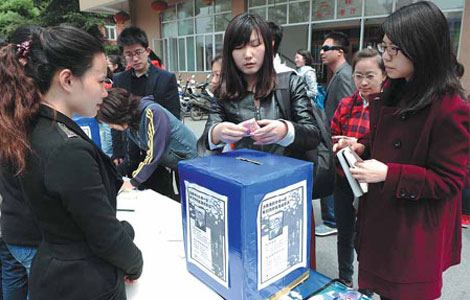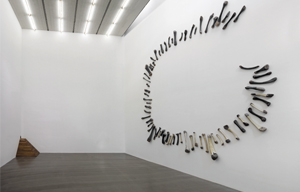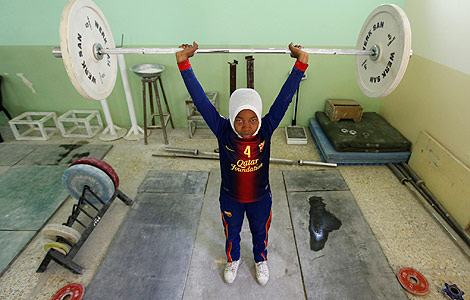True colors for all as Continua paints a picture of optimism
Updated: 2013-05-06 10:35
By Sun Yuanqing (China Daily)
|
|||||||||||
 |
|
Federica Beltrame, director of the Galleria Continua Beijing, in the capital's 798 Art Zone. Photo/China Daily |
There's no shortage of work by international artists on view in Beijing, but they tend to be grouped in galleries by their country of origin.
Noting this, Gallery Continua decided eight years ago to open a branch in China that, rather than promote art from its homeland Italy, would be truly international.
"We just show good international art unlabeled by any country or region," said Federica Beltrame, director of the Beijing gallery, in the 798 Art Zone.
However, most of what it sold went overseas, and it relied on support from its Italian parent gallery near Florence.
This year, as a measure of its open strategy success coupled with an optimistic outlook, Gallery Continua Beijing has decided to go it alone and become financially independent.
The main reason for the optimism is that it is starting to see a growing interest among Asian collectors.
"We made this decision because we have faith that we can count on these Asian collectors and new ones that we are meeting," said Beltrame.
The gallery sold three art works at the Art Stage Singapore fair this year. It is also going to Art Beijing, Art Basel in Hong Kong and the Shanghai Biennale, for the first time without the assistance from its Italian parent company.
"The art fair is our main income," Beltrame added. "And we will concentrate more on selling to collectors to become independent. We're going to be under more pressure this year." Until now, the market in China did not appear ready to buy Western art. Usually, the works Continua exhibited in Beijing were sold elsewhere. The situation is changing, although slower than expected.
"There are more collectors from China and Asia in general that are showing a greater interest in Western art. But it's going much slower than we thought," Beltrame said.
Until 2008, the gallery had no local collectors as clients, only two Western collectors. As the Chinese contemporary art market shrank after the financial crisis, however, people started thinking differently.
"They start thinking, 'What is art and what is solid?' They came to us because we were representing artists like Antony Gormley and Anish Kapoor," Beltrame said. "They have been on the scene for a long time and have grown slowly, and now they are established."
Production costs for sculptures and installations, as well as running expenses, in the 798 Art Zone of Beijing also rose rapidly after the 2008 financial crisis. So, the gallery now holds three exhibitions each year, compared to four to five before 2008.
"It's a very hard place to be," she said. "People are eager to see more art from all over the world, but the bureaucratic situation in China is so complicated. It really penalizes you whatever option you take. If you come here to do business, it's not easy to see the results."
However, the idea of closing the gallery in Beijing to open in another more business-friendly environment has never crossed her mind.
"There is a certain magic atmosphere in Beijing," she said. "To have a gallery here is like having an important window. People come from all over the world to see the installations we do.
"Even though it's difficult to sell, we still do it, because by presenting such important work, we give another view of the artist's work. Maybe because you have seen the installation, you become interested in the artist and you might purchase something smaller."
The space modeled from an old factory in the 798 Art Zone is also something the gallery would find impossible to give up.
"It feels almost like home. This space is really loved. It is completely empty and white. It's like giving an artist a complete white canvas and saying, 'Get crazy, do whatever you want.' It's really demanding and challenging. They do the best they can because they know that this is a big thing to be represented here."
The Italian company of Continua is based in San Gimignano, a small medieval town near Florence. It has another gallery in an outer suburb of Paris, "in the middle of field with cows and a river".
"None of these places is an easy location for a gallery to operate in," Beltrame said. "If we wanted to make money quickly, we would have a branch in New York, Hong Kong or London.
"But Continua believes that art is something you have to enjoy - just as in life you enjoy eating, drinking and the weather."
|
|
|
| The lost art of a gallery |
Related Stories
Looking forward to history repeating 2013-05-06 09:57
Portrait of a portraitist 2013-05-03 09:51
Venice walls inspire photographer 2013-05-02 17:45
Kunqu Opera's great survivor 2013-05-02 10:24
Building while reflecting 2013-05-01 17:05
Bird-like sculpture hits Guagnzhou 2013-04-28 14:25
Today's Top News
Renewed interest in mission to Mars
Suspects accused of selling tainted pork
Xi pins hope on youth for innovation, advancement
China playing bigger role in Middle East
FM wraps up tour on
note of stability
Museum window vandalized
Seawater can save thirsty country
New markets buy big at trade fair
Hot Topics
Lunar probe , China growth forecasts, Emission rules get tougher, China seen through 'colored lens', International board,
Editor's Picks

|

|

|

|

|

|







